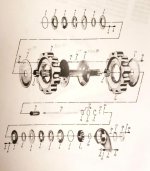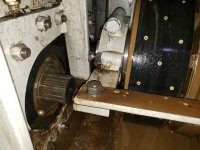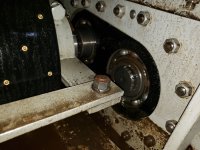I recently purchased a muskeg with a drive issue I'm trying to figure out and had a few questions. I believe it is about a 1994 or 1995 based on date code on the engine. Very odd that Bombardier chose not to put date of manufacture on the name plate...
The machine is not sending power to the right track. What is strange though is I get power to the left track if I pull either brake - or both at once. it makes sense that if there was a broken axle or differential issue that stopping free spin on the right would send traction to the left but I"m not sure why I get good traction to the left with the left brake? I pulled the axle end caps but not much to see there. both brakes have good movement on the actuators. Anything else I should check before I pull the differential cover? It is pretty crammed under the front of the motor, radiator, and auxiliary hydraulic cooler but I "think" I can get it out without pulling the cab.. I'm worried about removing it and breaking bolts though.
anywhere I can find a full differential and axle diagram online?
what is the function of the narrow rods inside the front drive axles? both of mine have the castle stripped off and were just sitting under the cover but it doesn't seem that rod does anything critical from a drive perspective. There is more than enough stub in the axle to stay in the end cap from what I see so not sure if it is critical to try to fix them and get the nuts back on?
Are there any other forums or resources for muskegs you recommend? this forum seems to come up the most in searches.
thanks much! Hoping to spend some restoration time on this unit but for now just want to get it functional. It runs great!
The machine is not sending power to the right track. What is strange though is I get power to the left track if I pull either brake - or both at once. it makes sense that if there was a broken axle or differential issue that stopping free spin on the right would send traction to the left but I"m not sure why I get good traction to the left with the left brake? I pulled the axle end caps but not much to see there. both brakes have good movement on the actuators. Anything else I should check before I pull the differential cover? It is pretty crammed under the front of the motor, radiator, and auxiliary hydraulic cooler but I "think" I can get it out without pulling the cab.. I'm worried about removing it and breaking bolts though.
anywhere I can find a full differential and axle diagram online?
what is the function of the narrow rods inside the front drive axles? both of mine have the castle stripped off and were just sitting under the cover but it doesn't seem that rod does anything critical from a drive perspective. There is more than enough stub in the axle to stay in the end cap from what I see so not sure if it is critical to try to fix them and get the nuts back on?
Are there any other forums or resources for muskegs you recommend? this forum seems to come up the most in searches.
thanks much! Hoping to spend some restoration time on this unit but for now just want to get it functional. It runs great!



